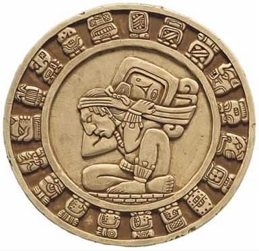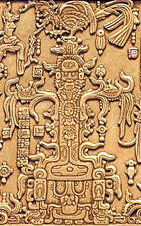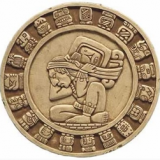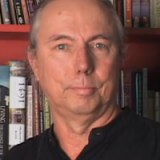The Mayan Calendar and the Transformation of Consciousness, by Carl Johan Calleman, Ph.D.
The Mayan Calendar and the Transformation of Consciousness, by Carl Johan Calleman, Ph.D. is published by Bear & Company Press.
Curiosity about the phenomenon of the Mayan Calendar end date was first popularized by José Argüelles and his Dreamspell divination device.
However, his highly stylized renderings of Mayan glyphs and “intuitive” changes to the accepted structure of the calendar itself caused the academic community and even Mayan elders to dismiss the validity of his research and conclusions.
Mayan Calendar End Date: 2012 Versus 2011?
 Then along came Carl Johann Calleman, Ph.D. who, among other things, changed the heretofore sacrosanct end date of the calendar cycle from December 21, 2012 to October 28, 2011. Now the fat was really in the fire. Among others, John Major Jenkins, independent researcher and author, stepped forward to champion the cause of the classically accepted 2012 date based on the alignment of the solstice sun on that date with the center of the Milky Way Galaxy, an event that repeats every 26,000 years.
Then along came Carl Johann Calleman, Ph.D. who, among other things, changed the heretofore sacrosanct end date of the calendar cycle from December 21, 2012 to October 28, 2011. Now the fat was really in the fire. Among others, John Major Jenkins, independent researcher and author, stepped forward to champion the cause of the classically accepted 2012 date based on the alignment of the solstice sun on that date with the center of the Milky Way Galaxy, an event that repeats every 26,000 years.
Calleman’s contention is there are two calendars; one linked to earthly events and astronomy-the Long Count, the other a sacred calendar reflecting the cosmic pulse of a divine plan independent of astronomy.
Insights into Mayan Mysteries
Calleman’s book is a treasure trove of history, myth and insight into one of the most remarkable achievements in human history, the Mayan calendar. His proposal is that we moderns learn the intricacies of the calendar in order to evolve our consciousness by syncing with the planetary, galactic and universal “high frequency evolutionary cycle”. “For the most part, our senses have been dulled by living in a society and environment that do not encourage our sensitivity to the divine flow of time. This dulling of the senses has been fortified by the almost universal rule of astronomically-that is, physically-based calendars.”
 All interpretations of the Mayan calendar are based on the tzolkin, the count of days, with 20 day signs and thirteen numbers which comprise a 260 day cycle before repeating itself. For mundane purposes this cycle is synchronized with a 365 day haab for a calendar round of 52 years before repeating. Calleman does not use the haab in his calculations instead using the 360 day tun. He claims the ancient Egyptians used a 360 day “divine” calendar and “The use of the 360-day year for spiritual purposes is known from ancient India, Peru, Scandinavia, Israel and Rome. The Chinese used a religious calendar based on the 360-day year in parallel with the civil calendar of 365 days”. Hence, the discrepancy with the established archaeological end date.
All interpretations of the Mayan calendar are based on the tzolkin, the count of days, with 20 day signs and thirteen numbers which comprise a 260 day cycle before repeating itself. For mundane purposes this cycle is synchronized with a 365 day haab for a calendar round of 52 years before repeating. Calleman does not use the haab in his calculations instead using the 360 day tun. He claims the ancient Egyptians used a 360 day “divine” calendar and “The use of the 360-day year for spiritual purposes is known from ancient India, Peru, Scandinavia, Israel and Rome. The Chinese used a religious calendar based on the 360-day year in parallel with the civil calendar of 365 days”. Hence, the discrepancy with the established archaeological end date.
“The tzolkin by itself is thus a pattern for the unfolding of creative energy rather than a calendar.”
Archaeologists, Treasure Hunters and Spiritual Pilgrims
The vast majority of books about and explorations of the “Americas” are by euro-centric men with a variety of ulterior motives, often the acquisition of treasure whether gold and land or academic prowess and fame.
 The name America derives from one such explorer/cartographer, Americus Vespucci whose famous first name translates “lover of riches.” Another motive has been to prove a dearly held point of faith. Renowned meso-america explorer, photographer and antiquarian Augustus Le Plongeon (1825-1908) made some of the most remarkable discoveries in the checkered history of archaeology, especially around Chichen Itza, all to prove “their relation to the sacred mysteries of Egypt, Greece, Chaldea and India.” More importantly, “Free Masonry, in times anterior to the Temple of Solomon.” His use of dynamite to “unveil the mysteries” of the Caracol at Chichen may have been the last straw for this anti-papist Mason in the eyes of the Catholic Mexican government and he was unceremoniously asked to leave.
The name America derives from one such explorer/cartographer, Americus Vespucci whose famous first name translates “lover of riches.” Another motive has been to prove a dearly held point of faith. Renowned meso-america explorer, photographer and antiquarian Augustus Le Plongeon (1825-1908) made some of the most remarkable discoveries in the checkered history of archaeology, especially around Chichen Itza, all to prove “their relation to the sacred mysteries of Egypt, Greece, Chaldea and India.” More importantly, “Free Masonry, in times anterior to the Temple of Solomon.” His use of dynamite to “unveil the mysteries” of the Caracol at Chichen may have been the last straw for this anti-papist Mason in the eyes of the Catholic Mexican government and he was unceremoniously asked to leave.
So what are Calleman’s ulterior motives?
 There have been hints, but by chapter 4, “The existence of God has been scientifically proved, and we may now study the actual workings of the cosmic plan.” Cue the organ music. By the end of the book, Calleman is in full voice, calling for “. . . the return of an apprehension of the living cosmos. The enlightenment that this cycle brings will allow for true and complete healing and forgiveness of the past, which humans will also extend to God, whose relationship with human beings . . . has sometimes been perceived as antagonist.” Huzzah, huzzah! Yahweh’s got some ‘splainin’ to do. “We will come to live in a New Jerusalem.” This is a good thing, property values being on the decline these days in the Old Jerusalem.
There have been hints, but by chapter 4, “The existence of God has been scientifically proved, and we may now study the actual workings of the cosmic plan.” Cue the organ music. By the end of the book, Calleman is in full voice, calling for “. . . the return of an apprehension of the living cosmos. The enlightenment that this cycle brings will allow for true and complete healing and forgiveness of the past, which humans will also extend to God, whose relationship with human beings . . . has sometimes been perceived as antagonist.” Huzzah, huzzah! Yahweh’s got some ‘splainin’ to do. “We will come to live in a New Jerusalem.” This is a good thing, property values being on the decline these days in the Old Jerusalem.
Some pretty tough gristle for this anarcho-buddhist to chew, but I don’t have to swallow it to garner some jewels of great research Calleman provides. The book is densely packed with correlations, mostly between science, monotheism and “new age” consciousness studies. We get some great updated interpretations of many dubious Judeo-Christian concepts like the “fall” from the garden of Eden, original sin, judgment day, Armageddon and Christ-consciousness. Unfortunately his take on Buddhism is seriously flawed, “. . . very few, if any, of the Buddha’s disciples attained the enlightened state . . .”, and his use of the Hopi prophecy to explain time, is ludicrous. The Hopi language and world view contain no word or concept that is anywhere near our comprehension of time.
In Search Of Meaning
 I’ve excised from this review a lengthy explanation I wrote condensing Calleman’s excellent exposition of the structure of the Mayan calendar; the World Tree, the nine underworlds and 13 heavens, the accurate dating of the Big Bang, the date of the sudden emergence of human “civilization.” However, I must leave you, dear reader, with this question. Does it seem to you that time is speeding up, that things in your life are changing faster than the storage capacity of cheap hard drives?
I’ve excised from this review a lengthy explanation I wrote condensing Calleman’s excellent exposition of the structure of the Mayan calendar; the World Tree, the nine underworlds and 13 heavens, the accurate dating of the Big Bang, the date of the sudden emergence of human “civilization.” However, I must leave you, dear reader, with this question. Does it seem to you that time is speeding up, that things in your life are changing faster than the storage capacity of cheap hard drives?
“Paradoxically, as the Mayan Calendar system draws to a close, on one hand time will be experienced as moving faster than ever before, and on the other hand as if it is not moving at all.” Each of the nine underworlds is a different span of time, representing a stage of evolution, coexisting with the same end date, October 28, 2011 (by Calleman’s reckoning).
The 1st underworld lasts over 16 billion years, the 9th and final a mere 260 days. For our purposes, we’re dealing with the calendar round beginning with the 6th underworld in 3115 BCE through the 9th. “This reflects a frequency of change of the heavenly energies that by far surpasses anything that anyone has experienced.” What’s going to happen? As my Mayan beer buddy said to me on the shore of Cozumel island, “quien sabe”. Who knows.
To learn more visit Amazon > The Mayan Calendar and the Transformation of Consciousness

Writer, photographer, raconteur, Curtis McCosco fled from academia to further his education in Haight-Ashbury and the streets of Hollywood. He’s worked as a furniture maker, Moviola repairman, documentary film maker, Motown tech, carpenter, masseur, and explores the the worlds of indigenous wisdom and shamanism, Hermetic occultism, remote viewing, history, politics and the evolution of consciousness, all from a Buddhist perspective. You can find more of his writing on his blog, NOOZINE.com.









I’am hoping this will be the timing of the rise of Christ Consciousness in the prevailing human race, to save the planet that we live on.
Sir, who are the Mayas? We have no idea of their origin and then how we can predict things from their ancient symbolical calender. Are we guessing only? Any firm evidence to the prediction are not with us.
Had Mayan Tribes been influenced by Hinduism. Do they still exist?